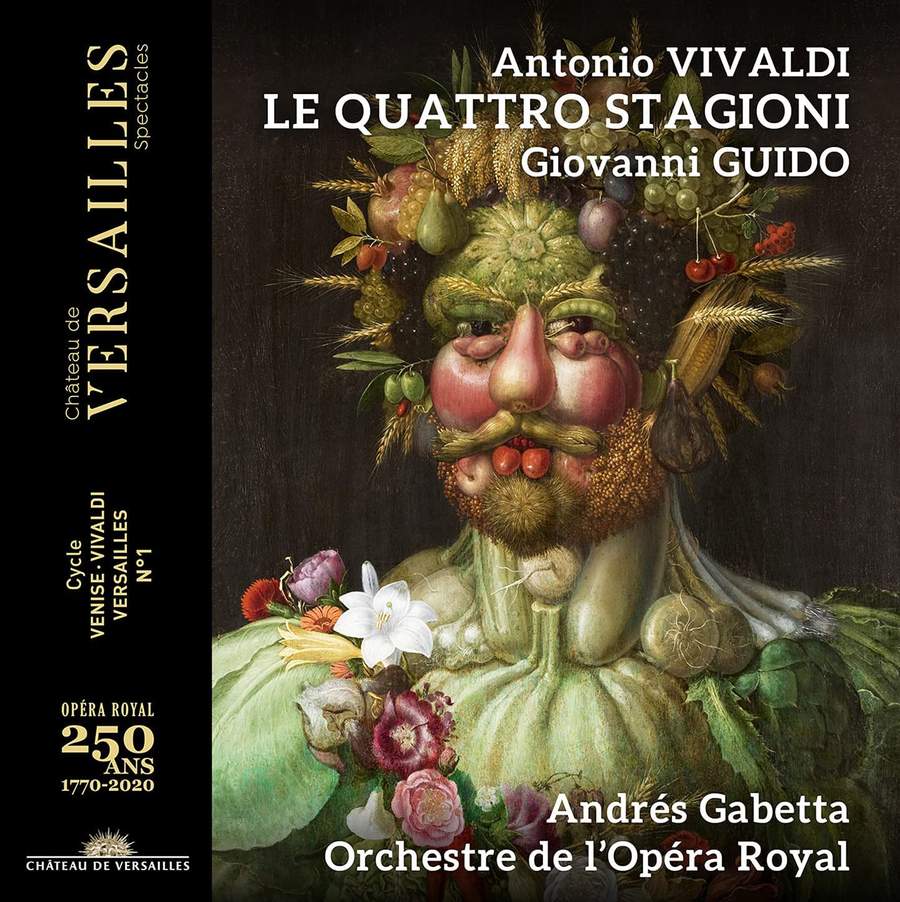GUIDO; VIVALDI The Four Seasons (2 CD + DVD)
View record and artist detailsRecord and Artist Details
Genre:
Orchestral
Label: Château de Versailles Spectacles
Magazine Review Date: 10/2021
Media Format: CD or Download
Media Runtime: 94
Mastering:
DDD
Catalogue Number: CVS042

Tracks:
| Composition | Artist Credit |
|---|---|
| (12) Concerti for Violin and Strings, '(Il) cimento dell'armonia e dell'inventione', Movement: Nos 1 - 4, 'The Four Seasons' |
Antonio Vivaldi, Composer
Andres Gabetta, Conductor Orchestre de l'Opéra Royal |
| Le Quattro Stagioni (The Four Seasons) |
Giovanni Antonio Guido, Composer
Andres Gabetta, Conductor Orchestre de l'Opéra Royal |
Author: Charlotte Gardner
You can always count on the Château de Versailles team to come up with an eminently classy-feeling musical bundle and this double-CD and DVD box, recorded over six days in the Palace of Versailles’s Hall of Mirrors, is no exception. On aesthetics alone, it’s a thing of beauty with various Arcimboldo paintings gracing the various black-and-gold covers, and it’s equally striking from a repertoire and performance perspective.
It’s a thorny question as to who influenced whom (if anyone influenced anyone) when it comes to Vivaldi’s Four Seasons and the Scherzi armonici sopra le quattro stagioni dell’anno by Giovanni Antonio Guido, a Neapolitan violinist and composer who arrived and settled in Paris in 1702. Both are seasons-themed programmatic works attached to poems; both were probably written in the mid-1710s then published respectively in 1725 and 1726; and there are solid arguments for all theories. What is indisputable, though, is that the Guido is a fantastic partner to the Vivaldi: a deliciously bucolic and toe-tapping set that honours the Italian virtuoso style of violin-playing while rejecting the three-movement concerto form you’d usually hear it in – plumping instead for French-style multi-movement orchestral suites drawing on dance forms, and then serving up a constantly changing roller coaster of colour, texture and timbre. Take Spring’s ‘Muzete’, with its rollicking hurdy-gurdy; or the lightning-speed fun of Summer’s ‘Chant des coucous’, its merry cuckoo calls (incidentally a popular Vivaldian motif) falling to the recorders; or the violins’ sul ponticello stabbing figures at the start of Winter’s ‘The Season of Frost’ (note that Vivaldi used sul ponticello in his own Winter). It really swings under these musicians’ fingers, too, via crisply articulated, upbeat and graceful readings that clearly honour both the music’s dance roots, its frothy fun (I love the birdsong whistle) and the programmatic element – you’ll find the poems in the booklet.
On to the Vivaldi, and the first defining feature is the addition of wind instruments – something the Dresden Court Orchestra would do to originally strings-only works while under the leadership of Vivaldi’s friend Pisendel. Often this makes for interesting extra colour that’s worth making the effort to get on board with; notably when recorder replaces the second violin solo in Spring’s birdsong-themed first episode. However, that aforementioned birdsong whistle is also in the mix, which in this context sounds dangerously close to twee.
Another defining feature is the choice of brisk tempos which, in conjunction with airily crisp, neatly clipped articulation, produces a set of interpretations that feel quite cool. Compare it with those from bands such as La Serenissima (Avie, 10/15) or Alexandra Conunova’s hand-picked ensemble (Aparté, 1/21) and you’ll hear what I mean. Still, whatever your taste, the speed also produces some fabulous effects thanks to the sort of phenomenally precise ensemble playing that doesn’t happen merely from watching each other. These musicians are breathing as a single body and the yield is string tremolo so fine it barely sounds like individual notes, hairpin swells coming like sharply defined waves and semiquaver runs heard as single rushes of sound; Summer’s thunderstorm sounds properly elemental. Equally from Gabetta it’s a story of coolly elegant precision and virtuosity, with his strongly rubato’d solos injecting further drama.
As for the DVD’s filmed concert, this was recorded in the middle of the run of sessions for the audio recordings – the hall itself feels more prominently captured, and the Vivaldi doesn’t get off to quite such a high-speed start. It’s an enjoyable bonus to an offering that’s worthy of your time for the Guido alone, while also presenting an admirable alternative to the Four Seasons norm. Bird whistles notwithstanding.
Discover the world's largest classical music catalogue with Presto Music.

Gramophone Digital Club
- Digital Edition
- Digital Archive
- Reviews Database
- Full website access
From £8.75 / month
Subscribe
Gramophone Full Club
- Print Edition
- Digital Edition
- Digital Archive
- Reviews Database
- Full website access
From £11.00 / month
Subscribe
If you are a library, university or other organisation that would be interested in an institutional subscription to Gramophone please click here for further information.




